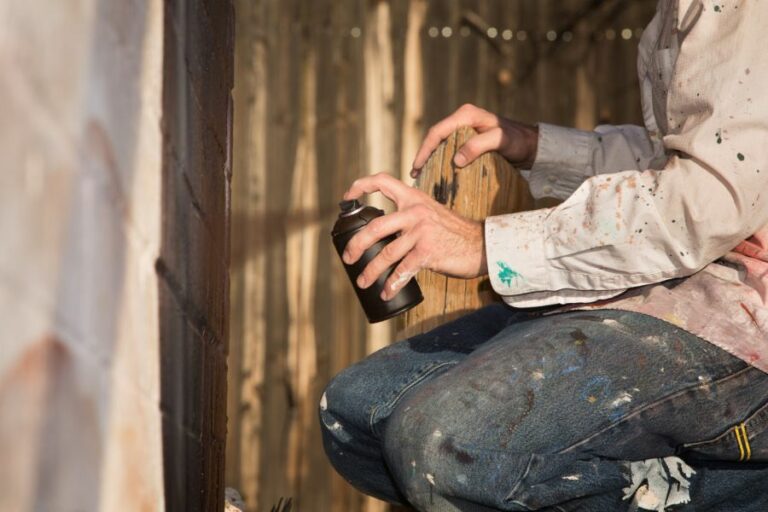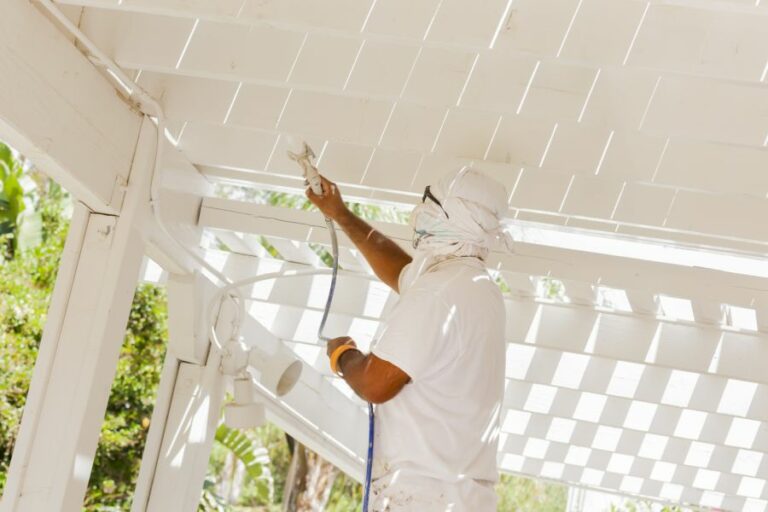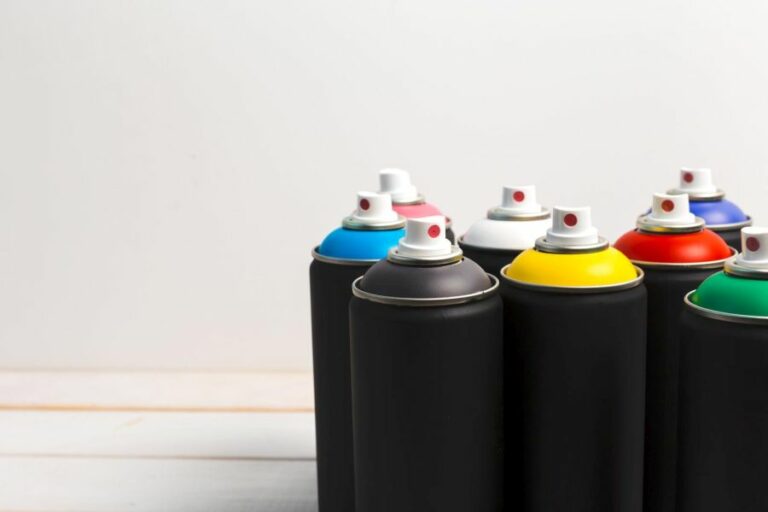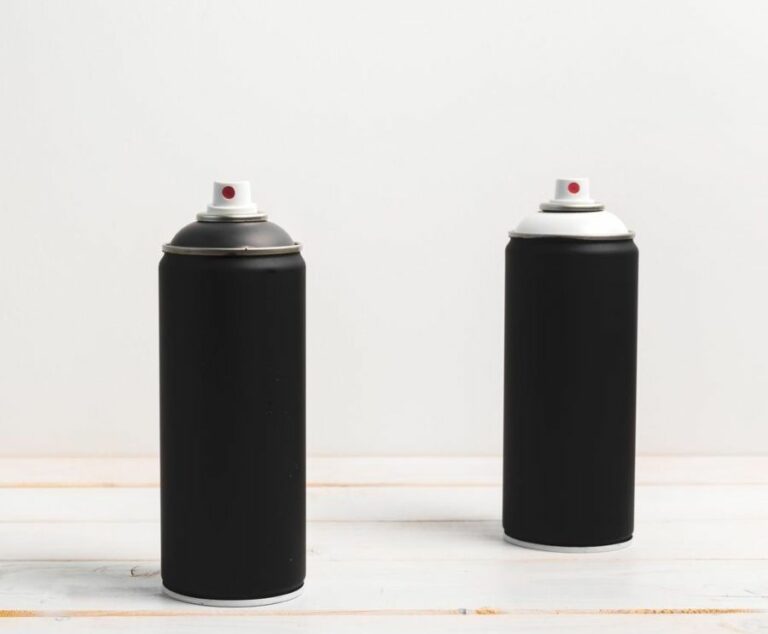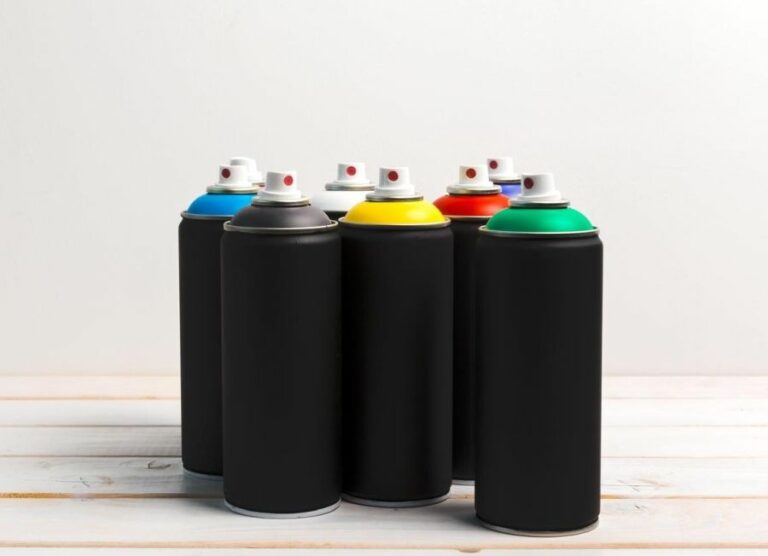Common Mistakes To Avoid When Spray Painting Plastic
When spray painting plastic, it’s not uncommon for DIY enthusiasts or even professionals to encounter a few obstacles. However, you can achieve a smooth, even finish with the right knowledge and techniques. In this article, I will discuss some common mistakes that are easy to avoid while spray painting plastic, ensuring you’ll always achieve the perfect result.
Common mistakes to avoid when spray painting plastic:
To avoid common mistakes when spray painting plastic, ensure proper surface preparation, use appropriate paint types, apply correct painting techniques, consider temperature and humidity conditions, and add a protective clear top coat. Proper preparation and technique result in professional-looking, durable painted plastic projects.

Are you struggling with a streaky, uneven finish while spray painting plastic? There are some common mistakes that people make during the process. Continue reading to discover useful tips and expert guidance that will help you achieve a flawless finish on your plastic projects.
Contents
- 1 Avoid These Mistakes When Spray Painting on Plastic
- 2 Master the Art of Spray Painting on Plastic Flawlessly
- 2.1 • Step 1: Choose the Right Paint
- 2.2 • Step 2: Prepare the Surface
- 2.3 • Step 3: Setup Your Workspace
- 2.4 • Step 4: Apply a Primer (Optional)
- 2.5 • Step 5: Shake the Paint Can
- 2.6 • Step 6: Start Spray Painting
- 2.7 • Step 7: Allow the Paint to Dry
- 2.8 • Step 8: Apply Additional Coats (If Necessary)
- 2.9 • Step 9: Apply a Clear Coat (Optional)
- 2.10 • Step 10: Assemble and Enjoy!
- 3 Is Direct Spray Painting on Plastic Possible?
- 4 Reasons for Spray Paint’s Poor Adhesion to Plastic
- 5 Importance of Priming Plastic Prior to Spray Painting
Avoid These Mistakes When Spray Painting on Plastic
Spray painting plastic can be a convenient and cost-effective way to update various household items or create stunning DIY projects. However, some common mistakes can turn your project into a frustrating experience.
• Insufficient Preparation of the Plastic Surface
The first and most crucial step in the spray painting process is surface preparation. Failing to properly prepare the surface of the plastic can lead to uneven paint coverage, bubbling, or peeling. To save time and energy, follow these tips:
- Cleaning: Thoroughly clean the plastic surface with a solution of warm water and mild detergent to remove any dirt, dust, or grease. Rinse well and allow it to air dry, or wipe it down with a clean, lint-free cloth.
- Sanding: Lightly sand the surface with fine-grit sandpaper (around 220-300 grit) to provide better adhesion for the paint. Wipe the surface again with a damp cloth to remove any dust from the sanding.
- Primer: Applying a plastic primer before painting helps create a stable base for the spray paint to adhere to. Make sure to choose a primer specifically designed for plastic surfaces.
• Using the Wrong Type of Paint
Not all spray paints are suitable for plastic surfaces. Utilizing the wrong paint can lead to poor adhesion and chipping, or the paint may take a long time to dry. To avoid these issues, consider choosing spray paint specifically labeled for use on plastic materials or follow these recommendations:
- Acrylic-based spray paint works well on plastic, as it dries quickly and provides a durable finish.
- Enamel spray paint is another option that adheres exceptionally well to plastics, but it takes longer to dry and may require a clear coat to protect the finish.
• Improper Painting Technique
An improper painting technique is another common mistake when spray painting plastic. This can result in an uneven finish, paint drips, or a significantly thick layer of paint. To achieve smooth, professional-looking results, keep these tips in mind:
- Shaking the can: Vigorously shake the spray paint can for at least one minute before using it to ensure proper paint mixing and smooth spraying.
- Distance: Maintain a consistent distance of about 8 to 12 inches from the surface throughout the painting process.
- Spray motion: Use a steady, side-to-side motion while maintaining a consistent speed. This helps prevent patchiness, drips, and over-spraying.
- Thin layers: Apply multiple thin coats of paint rather than a single thick one. This allows the paint to cure evenly, prevents drips, and results in a smoother finish. Wait for the recommended drying time between coats, as specified on the spray paint can.
• Ignoring Temperature and Humidity Conditions
Temperature and humidity can significantly impact the outcome of your spray painting project. High humidity or extreme temperatures can cause the paint to dry irregularly or result in a cloudy or cracked finish.
To avoid this, follow these guidelines:
- Ideal conditions: Optimal spray painting conditions are between 50-90F with a relative humidity of 40-70%.
- Avoid direct sunlight: Paint your plastic object in a shaded, well-ventilated area to prevent the paint from drying too quickly or unevenly.
- Check paint instructions: Always read and follow the recommendations on the spray paint can regarding suitable working conditions.
• Skipping the Finishing Touches
To protect your freshly painted plastic item and enhance its durability, consider applying a clear top coat once the paint has completely dried.
This is especially important if the plastic item will be frequently handled, exposed to sunlight, or used outdoors. Make sure to choose a clear coat compatible with your spray paint type.
By avoiding these common spray painting mistakes and following the tips provided above, you can confidently create impressive, professional-looking plastic paint projects. Remember that practice always makes perfect, so don’t be afraid to learn from any mistakes you make along the way.
Mistake | How to Avoid |
|---|---|
Not cleaning the surface | Thoroughly clean and dry the surface before painting. |
Not using a plastic primer | Apply a plastic primer to ensure proper adhesion of the paint. |
Applying too thick of a coat | Apply thin coats and let each coat dry before applying the next. |
Not allowing enough drying time | Follow the drying time recommendations on the paint can. |
Spraying too close to the surface | Keep the spray nozzle at least 10-12 inches away from the surface. |
Not sanding glossy surfaces | Lightly sand any glossy surfaces to help the paint adhere better. |
Not removing loose or peeling paint | Remove any existing loose or peeling paint before painting. |
Not protecting surrounding areas | Cover any surrounding areas to avoid overspray. |
Master the Art of Spray Painting on Plastic Flawlessly
Spray painting plastic can be a challenging yet rewarding task when done correctly.
• Step 1: Choose the Right Paint
Using the correct type of paint is vital to achieving a successful outcome. Not all paints adhere well to plastic, which is why it’s essential to select paint specifically designed for this purpose. I recommend using a paint that includes a primer, as it ensures better adhesion and surface coverage.
Krylon Fusion and Rust-Oleum Painter’s Touch 2X Ultra Cover are two popular options to consider for spray painting plastic.
• Step 2: Prepare the Surface
Before spray painting, thoroughly clean the plastic surface to remove any dirt, dust, or grease. You can use a mild detergent mixed with water or rubbing alcohol for this purpose. After cleaning, rinse the surface with water and let it dry completely.
For a smoother surface, consider lightly sanding the plastic using a fine-grit sandpaper (320 or 400 grit) to generate better paint adhesion. After sanding, use a tack cloth or a damp rag to remove any dust or debris, ensuring a clean surface.
• Step 3: Setup Your Workspace
Choose a well-ventilated area, such as a garage or an outdoor space, for spray painting. Protect the surrounding area from overspray by covering it with newspaper, drop cloths, or plastic sheets.
To prevent the item from sticking to the surface, you can use a painting stand, painter’s pyramids, or even sticky tacks underneath the object.
• Step 4: Apply a Primer (Optional)
While it’s possible to use paint that already includes a primer, applying a separate primer may provide a smoother finish and improved adhesion.
Select a primer designed specifically for plastic surfaces. Apply the primer in a light, even coat, following the manufacturer’s instructions on the can. Let the primer dry fully before moving on to the next step.
• Step 5: Shake the Paint Can
Shaking the paint can vigorously for at least one minute ensures the paint is properly mixed and ready for application. This also helps to prevent clogging in the spray nozzle.
• Step 6: Start Spray Painting
Hold the spray can about 10 to 12 inches away from the surface. This distance will help ensure an even and controlled spray, reducing the chance of drips, runs, or uneven coverage.
Begin spraying off the edge of the plastic, then move across the surface in a continuous motion. Release the spray nozzle after each pass, then start the next pass off the edge again. This method reduces potential paint buildup, which can lead to drips or an uneven finish.
Apply the paint in thin, even layers, waiting a few minutes between each coat. Following this technique allows for a smoother and more durable finish.
• Step 7: Allow the Paint to Dry
Each paint brand and type have different drying times, so refer to the manufacturer’s recommendations on the can. Generally, it can take anywhere from 10 minutes to 24 hours for the paint to become dry to the touch. Depending on the paint, it may take up to a week for it to fully cure and harden.
• Step 8: Apply Additional Coats (If Necessary)
If the desired color and coverage have not yet been achieved, apply additional coats of paint. Be sure to wait for the recommended drying time between coats, ensuring the previous coat has dried completely. Applying too many coats or not waiting for the paint to dry can lead to cracks or an uneven finish.
• Step 9: Apply a Clear Coat (Optional)
For extra protection and durability, consider applying a clear coat after the final layer of paint has dried. A clear coat provides a protective layer against UV rays, scratches, and other potential damage.
Choose a clear coat specifically designed for plastic surfaces and follow the manufacturer’s instructions for proper application.
• Step 10: Assemble and Enjoy!
Once the paint and clear coat (if applied) have fully dried and cured, you can reassemble any parts previously removed and enjoy your newly painted plastic item. With the proper care, your newly painted surface should remain vibrant and durable for years.
By following these steps and taking the time to properly prepare and paint your plastic surface, be it furniture, toys, or decoration pieces, you can achieve professional, long-lasting results.
Step | Description |
|---|---|
1 | Clean the plastic surface thoroughly using soap, water, and a sponge. Rinse and dry completely. |
2 | Slightly sand the plastic surface with fine-grit sandpaper (around 220 grit) to create better adhesion for te paint. |
3 | Wipe down the surface with a tack cloth to remove any sanding dust or debris. |
4 | Apply a plastic primer to the surface according to the manufacturer’s instructions. Allow it to dry completely. |
5 | Shake the spray paint can well, and apply the paint in light, even coats from a distance of 10-12 inches away from the surface. Allow each coat to dry before adding the next one. |
6 | Apply a clear topcoat if desired, following the manufacturer’s instructions. Allow the paint to dry and cure completely before using or handling the plastic item. |
Is Direct Spray Painting on Plastic Possible?
Spray painting on plastic may sound like an easy, convenient method of transforming your old plastic items into brand new-looking, stylish pieces.
However, one might wonder, can you spray paint directly on plastic, or are there any special preparations or techniques involved? The answer lies in understanding the basics of how plastic reacts to paint and the correct preparation process before beginning your spray paint project.
• Understanding the Challenges of Painting on Plastic
The major challenge with painting on plastic lies in its non-porous nature, making it difficult for the paint to adhere properly. Some paints might not even stick to the plastic surface, while others may leave an unappealing, uneven finish.
Therefore, it is essential to understand the different types of plastics and the compatible paint solutions to achieve the desired results.
– Different Paints for Different Plastics
When considering spray paint for plastic, you have several options, but not all paints are compatible with all plastics. For instance, latex paints and acrylic craft paints are generally ineffective on plastic.
I recommend using specialized spray paints specifically formulated for plastic surfaces, such as Krylon’s Fusion for Plastic or Rust-Oleum’s Painter’s Touch Ultra Cover.
These products have been designed to bond with the plastic material effectively and provide a durable, long-lasting finish.
• Preparing the Plastic Surface for Spray Painting
Success in spray painting directly on plastic largely depends on the preparation process. The following are the essential steps for preparing the plastic surface to ensure the best results of spray-painting:
– Cleaning the Plastic Surface
Before starting any spray paint project, it is crucial to clean the plastic surface thoroughly. Use warm water, a mild detergent, and a soft cloth to remove dirt, grease, and other contaminants. Ensure you thoroughly rinse the surface with clean water to remove any soap residue and allow it to dry completely.
– Sanding the Plastic Surface
For better paint adherence and a smoother finish, I recommend sanding the plastic surface. Use fine-grit sandpaper (about 400-grit) to lightly sand the surface in a circular motion, ensuring that you cover all areas.
This process creates micro-abrasions, allowing the paint to bond with the plastic more effectively. Once you’ve finished sanding, use a dry cloth to remove any dust or debris from the surface.
– Applying a Surface Primer (Optional)
While not always necessary, applying a surface primer designed for plastic can further improve paint adherence and provide a more even finish.
Primer also helps in preventing bleeding, peeling, or flaking of the paint. Be sure to choose a primer that is compatible with the type of plastic you are working with and follow the manufacturer’s instructions for application.
• Spray Painting Techniques for Plastic
Now that your plastic surface is clean and well-prepared, it’s time to move on to the spray painting process. Here are some expert tips and techniques to achieve the best results in painting directly on plastic:
– Proper Ventilation and Safety Precautions
Spray paint fumes can be harmful, so ensure that you work in a well-ventilated area. Also, protect yourself by wearing gloves, goggles, and a mask or respirator.
– Test Before You Paint
Before painting the plastic item, test your spray paint on a scrap piece or an inconspicuous area. This will help you understand how the paint works, its coverage, and the optimal spraying distance.
– Thin, Even Coats
Instead of applying one heavy coat of spray paint, opt for multiple thin, even coats. This approach reduces the chances of paint dripping or pooling, leading to a smoother finish.
– Drying Time
Make sure to follow the manufacturer’s instructions for drying time between coats and allow ample time for the paint to cure fully. Rushing this process can lead to tacky or chipping paint.
• Final Thoughts
In conclusion, yes, you can spray paint directly on plastic. However, for the best results, it’s essential to understand the plastic material’s compatibility with spray paint, prepare the surface appropriately, and follow the correct painting techniques.
With proper planning, patience, and the right tools, you can achieve a professional-looking finish that will extend the life and improve the appearance of your plastic items.
Step | Description |
|---|---|
1 | Select a suitable spray paint designed for plastic surfaces. |
2 | Clean the plastic surface with a mild detergent and warm water. Rinse and dry thoroughly. |
3 | Lightly sand the surface with fine-grit sandpaper to help the paint adhere. |
4 | Apply a plastic primer, following the manufacturer’s instructions, to further enhance paint adhesion. |
5 | Shake the spray paint can well for about a minute, and test on a scrap piece of cardboard to ensure a smooth, even spray. |
6 | Hold the can 10-12 inches from the surface and apply thin, even layers of paint, allowing each coat to dry according to the manufacturer’s recommendations. |
7 | Apply additional coats as needed to achieve the desired finish, allowing each layer to dry before applying the next. |
8 | Allow the final coat of paint to dry completely, as recommended by the manufacturer, before reassembling or using the plastic item. |
Reasons for Spray Paint’s Poor Adhesion to Plastic
Spray paint not sticking to plastic is a common issue faced by many DIY enthusiasts and professionals alike. There are several reasons why your spray paint may not adhere properly to the plastic surface.
• The Importance of Surface Preparation
The success or failure of a spray paint job can largely depend on the initial surface preparation. If the plastic surface is not properly prepared, it can result in the paint not adhering correctly, leading to peeling or flaking.
– Cleaning the Surface
In order for spray paint to stick effectively to plastic, the surface must be clean and free of dirt, dust, and grease. Any contaminants on the surface can prevent the paint from adhering, ultimately leading to paint peeling or flaking off.
To clean the plastic surface effectively, use warm soapy water and a soft cloth, making sure to remove any contaminants completely.
Once the surface is clean and free from contaminants, use a clean cloth and rubbing alcohol to wipe down the entire area, ensuring all residues are removed. Finally, allow the surface to dry thoroughly before proceeding to the next step.
– Sanding the Surface
One of the primary reasons for spray paint not sticking to plastic is the lack of adhesion between the smooth plastic surface and the paint. To overcome this issue, it is necessary to lightly sand the surface to create a rougher texture, which will allow the paint to grip better.
For best results, use fine-grit sandpaper (such as 400-grit) and lightly sand the entire surface. Make sure to sand evenly and cover all areas that will be painted. Remember to remove any dust resulting from sanding with a clean, damp cloth before proceeding to paint.
• Choosing the Right Spray Paint
Not all spray paints are suitable for use on plastic surfaces. It is important to choose a paint specifically designed for use on plastics to ensure proper adhesion and durability.
– Using Plastic-specific Paint
Many manufacturers offer specially formulated spray paints for plastic surfaces, which offer better adhesion and flexibility compared to regular spray paints. These paints often include a primer and paint in one, simplifying the process.
Always read the label and follow the manufacturer’s recommendations for use, including proper surface preparation and application guidelines.
– Applying a Primer
If you prefer to use regular spray paint on plastic, it is essential to apply a primer first. The primer serves as an intermediate layer between the plastic surface and the paint, promoting better adhesion and durability.
Look for primers specifically designed for use with plastics, such as an adhesion promoter or a plastic primer.
Apply the primer according to the manufacturer’s directions and allow it to dry completely before applying the spray paint.
• Correct Spray Paint Application Techniques
Improper spray paint application can also result in poor adhesion to the plastic surface. Follow these tips to ensure optimal paint coverage and adhesion:
– Shake the Can Thoroughly
Before starting the painting process, always shake the spray paint can vigorously for at least one minute. This allows the paint particles to mix evenly throughout the can, ensuring a uniform and consistent spray.
– Holding the Can at the Right Distance
Holding the spray paint can too close to the surface can cause the paint to pool and run while holding it too far away can result in a thin and uneven coat. To achieve the best results, hold the can approximately 10-12 inches away from the surface.
– Applying Thin and Even Coats
Applying multiple thin and even coats of paint is preferred over one thick coat. This method ensures better adhesion, coverage, and drying. Allow each coat of paint to dry according to the manufacturer’s recommended drying time before applying the next coat.
– Maintaining Proper Environmental Conditions
Temperature and humidity can significantly impact the adhesion of spray paint to plastic surfaces. It is recommended to paint in a well-ventilated area with a temperature between 50-90ºF and relative humidity below 85%.
Additionally, avoid painting under direct sunlight, as this can cause the paint to dry too quickly, leading to poor adhesion.
• Final Thoughts
In conclusion, the key to achieving successful spray paint adhesion to plastic lies in proper surface preparation, using the appropriate paint and primer, and following correct spray painting techniques.
By following these guidelines, you will be better equipped to prevent and resolve issues of spray paint not sticking to plastic surfaces.
For further information and guidance on spray painting techniques and applications, check out this comprehensive resource provided by the University of California, Davis: Spray Painting Best Practices.
Importance of Priming Plastic Prior to Spray Painting
Spray painting plastic can be a quick and affordable way to update a variety of household items, from furniture to decorations. However, the question of whether or not to prime the plastic surface before applying spray paint often arises.
• The Purpose of Priming
Priming a surface before painting, especially when dealing with plastic materials, has many advantages. The main function of the primer is to create a uniform surface that the paint can adhere to more effectively. This results in a smoother, more durable finish that is less likely to peel or crack over time.
Additionally, primer can enhance the paint’s opacity and color purity, as well as protect the plastic from damage and staining.
In most cases, it is highly recommended to prime plastic before spray painting to achieve the best results.
• Types of Plastic Primers
There are various types of primers available in the market, and they are designed for specific materials or purposes. Here, we will focus on plastic primers that are suitable for spray painting.
1. General Purpose Plastic Primer
General-purpose plastic primers are compatible with most types of plastics, including ABS, PVC, and acrylic. They provide a good bonding surface for the topcoat and are available in varieties such as brush-on, spray-on, and aerosol forms.
Some popular general-purpose plastic primers include Rust-Oleum Specialty Plastic Primer, Krylon Fusion All-In-One Primer, and Dupli-Color Plastic & Vinyl Primer.
2. Specialty Plastic Primer
Some plastic materials require a specific type of primer to ensure proper adhesion and a durable finish.
For example, the Tamiya Surface Primer L is specifically formulated for use on plastic modeling components, and the Krylon Automotive Adhesion Promoter is designed for use on polypropylene and TPO automotive surfaces.
3. Adhesion Promoters
While not strictly a primer, adhesion promoters are often applied before primer when working with difficult-to-paint plastic surfaces. They act as a kind of molecular “glue” that helps the paint stick to the plastic, ensuring more reliable paint adhesion.
Examples of adhesion promoters include the 3M Adhesion Promoter 4298 and the Bulldog Adhesion Promoter.
Before selecting a plastic primer for your project, make sure to check the compatibility with the specific type of plastic surface you’re working with and follow the manufacturer’s instructions.
• How to Prime Plastic for Spray Painting
Following a step-by-step process to properly prime your plastic surface will ensure the best possible results for your spray painting project.
– Step 1: Cleaning the Surface
Before applying any primer, it’s crucial to thoroughly clean the plastic surface to remove any dirt or oils that could interfere with paint adhesion. Use a mild detergent or isopropyl alcohol to clean the surface and allow it to dry completely.
– Step 2: Sanding the Surface
Lightly sand the plastic surface with fine-grit sandpaper (around 400-800 grit) to create a slightly roughened surface for the primer to adhere to. Wipe away any dust created during sanding with a clean, damp cloth, and allow the surface to dry.
– Step 3: Applying the Primer
Apply the chosen plastic primer or adhesion promoter according to the manufacturer’s instructions. Many plastic primers come in aerosol spray cans, making them easy to apply in an even, overlapping pattern.
Make sure to hold the spray can about 12-18 inches away from the surface, and apply the primer in multiple light coats, allowing each coat to dry before applying the next.
– Step 4: Sanding the Primer
After the primer has dried according to the manufacturer’s recommendations, lightly sand the primed surface with fine-grit sandpaper (600-1000 grit) to further smooth the surface and ensure proper paint adhesion. Wipe away any dust with a clean, damp cloth, and allow the surface to dry.
– Step 5: Painting
Once the primed surface is fully prepared and dry, you can proceed with applying your choice of spray paint. Be sure to follow the paint manufacturer’s instructions for the best results.
In conclusion, priming plastic before spray painting is a crucial step for achieving a professional, long-lasting finish. By selecting the appropriate primer, preparing the surface properly, and following the recommended application techniques, you can ensure the success of your spray painting project.
For additional information and resources, visit the American Coatings Association and explore their educational materials on primers and surface preparation.

